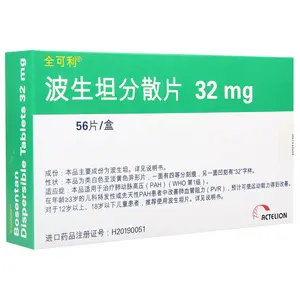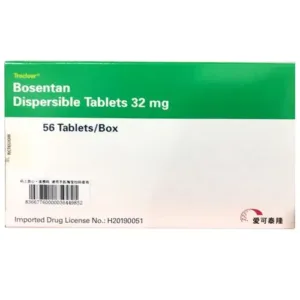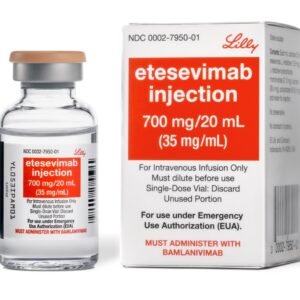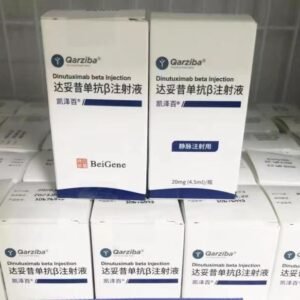Bosentan Dispersible Tablets
Function and indication: This product is suitable for the treatment of pulmonary arterial hypertension (PAH) (WHO Group 1): ●Improving pulmonary vascular resistance (PVR) in pediatric idiopathic or congenital PAH patients aged ≥3 years, which is expected to improve exercise capacity. For pediatric patients aged 12 years and above and below 18 years, Bosentan tablets are recommended, and the recommended dose refers to the instructions for Bosentan tablets. ●For the treatment of adult patients with pulmonary arterial hypertension (PAH) (WHO Group 1) of WHO functional grade II-IV to improve exercise capacity and reduce clinical deterioration. The efficacy study included patients with PAH of WHO functional grade II-IV, idiopathic or hereditary etiology (60%), PAH associated with connective tissue disease (21%), and PAH associated with congenital heart disease with left-to-right shunt (18%). The results of the comparison of the bioavailability of Bosentan dispersible tablets and Bosentan tablets in adult subjects showed that the exposure of Bosentan dispersible tablets was lower (see [Pharmacokinetics]). Therefore, this product can only be used in adult patients who cannot take Bosentan tablets.
Dosage and Administration:
This product should be decided by a doctor who has extensive experience in treating pediatric patients with pulmonary hypertension and strictly monitor the treatment process. When using, first dissolve this product in an appropriate amount of water, and then give the liquid to the patient. Table 1: Dosage recommendations for children (age ≤12 years) Patients (age ≤12 years) Initial 4-week and maintenance dose (after 4 weeks) ≥4-8kg 16mg/time, twice a day ˃8-16kg 32mg/time, twice a day ˃16-24kg 48mg/time, twice a day ˃24-40kg 64mg/time, twice a day ˃40kg 64mg/time, twice a day Pediatric patients (over 12 years old to under 18 years old): For children over 12 years old and under 18 years old, Bosentan tablets are recommended. The recommended dose refers to the instructions for use of Bosentan tablets. In children aged 12 years and older but younger than 18 years and weighing ≤40 kg who are unable to take bosentan tablets, the recommended initial and maintenance doses of this product are 64 mg/time, once in the morning and evening. In children aged 12 years and older but younger than 18 years and weighing ≥40 kg who are unable to take bosentan tablets, the recommended initial dose of this product is 64 mg/time, once in the morning and evening, for 4 weeks, followed by an increase to the recommended maintenance dose of 128 mg/time, once in the morning and evening. This product should be placed in a spoon and a small amount of water added, stirred to dissolve, and then swallowed. The patient should add a small amount of water to the spoon again and swallow to ensure that all the medicine is taken. If possible, a glass of water should be drunk to ensure that all the medicine is taken. If necessary, the tablet can be broken along the score on the surface. Pinch the two sides of the tablet with the thumb and index finger of both hands, with the score facing up, and break the tablet along the score (see the figure below). br>After breaking half of the tablet manually for use, the remaining part should be stored at room temperature and used within 7 days. This product is packaged in child-resistant blisters. The product should be taken out as follows: Separate the perforations and peel off the wrapping paper in the direction of the arrow to push out the dispersible tablets from the blister. Recommended dosage for adult patients This product has only been clinically studied in pediatric patients. Comparison of the bioavailability of bosentan dispersible tablets and bosentan tablets in adult subjects showed that the exposure of bosentan dispersible tablets was lower (see [Pharmacokinetics]). Therefore, this product can only be used in adult patients who cannot take bosentan tablets. In adult patients weighing ≤40kg, the recommended initial dose and maintenance dose of this product are 64mg/time, once in the morning and evening. In adult patients weighing >40kg, the recommended initial dose of this product is 64mg/time, once in the morning and evening, for 4 weeks, followed by an increase to the recommended maintenance dose of 128mg/time, once in the morning and evening. Dose adjustment for patients with persistently elevated transaminases Liver transaminase levels must be tested before treatment and reviewed monthly during treatment. If elevated transaminase levels are found, monitoring and treatment plans must be changed. The following table summarizes the dose adjustment and recommended monitoring for patients with persistent transaminase elevations >3 times the upper limit of normal during treatment with this product. If liver transaminases are elevated and accompanied by clinical symptoms of liver damage (such as anemia, nausea, vomiting, fever, abdominal pain, jaundice, lethargy and fatigue, flu-like syndrome (arthralgia, myalgia, fever)) or bilirubin increases ≥2 times the upper limit of normal, the drug must be discontinued and this product must not be re-administered. Table 2: Dosage adjustment and monitoring of ALT/AST levels in patients with persistent transaminase elevations >3 times the upper limit of normal Recommendations for dose adjustment and monitoring >3 and ≤5×ULN A liver function test should be performed again for confirmation; if confirmed, the daily dose should be reduced or the drug should be discontinued, and transaminase levels should be monitored at least every 2 weeks. If the transaminase returns to the pre-treatment level, the drug can be continued or restarted as appropriate. >5 and ≤8×ULN A liver function test should be performed again for confirmation; if confirmed, the drug should be discontinued, and transaminase levels should be monitored at least every 2 weeks. Once the transaminase returns to the pre-treatment level, the drug can be considered for re-administration. >8×ULN must be discontinued and not restarted. Restarting: Restarting should only be considered if the potential benefits of using this product outweigh the potential risks and transaminases return to pre-treatment levels. Restarting should be started from the initial dose, and transaminases must be tested within 3 days of restarting, and again after 2 weeks, and then monitored according to the above recommendations. Use in patients with liver damage before treatment This product should be contraindicated in patients with moderate and severe liver damage, and no dose adjustment is required for patients with mild liver damage. (See [Contraindications], [Precautions], [Pharmacokinetics]). Use in patients with renal impairment before treatment No dose adjustment is required for patients with renal impairment. No dose adjustment is required for patients undergoing dialysis. Combination use with ritonavir Combination use of this product in patients taking ritonavir: In patients who have received ritonavir for at least 10 days, start taking this product at the recommended initial dose, once a day or every other day, depending on the individual patient’s tolerability. Patients taking this product combined with ritonavir: This product should be discontinued at least 36 hours before starting ritonavir. After at least 10 days of ritonavir, resume dosing at the recommended initial dose of bosentan once daily or every other day, depending on individual patient tolerance. Missed dose If a dose of bosentan is missed during a scheduled dose, do not take a double dose to make up for the missed dose. Patients should take bosentan at the next scheduled dose. Discontinuation of treatment There is no experience of abrupt discontinuation of bosentan at the recommended dose in patients with pulmonary arterial hypertension. However, to avoid sudden clinical deterioration when other treatments for the same disease are discontinued, patients should be closely monitored and a gradual dose reduction (reducing the dose to half 3-7 days before discontinuation) should be considered. Disease monitoring should be strengthened during the discontinuation period.
Adverse Reactions:
In 20 placebo-controlled studies, patients were treated with bosentan for various indications. A total of 2486 patients were treated with bosentan (daily dose of 100mg–2000mg) and 1838 patients were treated with placebo. The average treatment duration was 45 weeks. Adverse reactions are defined as events with an incidence of not less than 1% in the bosentan treatment group and an incidence 0.5% higher than that in the placebo group. The most common adverse reactions were headache (11.5%), edema/fluid retention (13.2%), abnormal liver function test results (10.9%), and anemia/decreased hemoglobin (9.9%). Bosentan treatment is associated with dose-dependent increases in liver transaminases and decreases in hemoglobin concentrations (see [Precautions]). Adverse reactions/unexpected effects in 20 placebo-controlled bosentan studies are ranked by frequency: very common (≥1/10); common (≥1/100 to <1/10); occasional (≥1/1,000 to <1/100); rare (≥1/10,000 to <1/1,000); very rare (<1/10,000); unknown (cannot be estimated based on available data). Within each frequency group, adverse reactions are ranked from high to low severity. The difference in the incidence of adverse reactions between the total data set and the approved indications was not clinically significant. Table 3: Adverse reaction data of bosentan in 20 placebo-controlled studies and post-marketing experience System organ class Frequency Adverse reactions Blood and lymphatic system disorders Common Anemia, decreased hemoglobin (see [Precautions]) Unknown Anemia or decreased hemoglobin requiring red blood cell transfusion 1 Uncommon Thrombocytopenia 1 Uncommon Neutropenia, leukopenia 1 Immune system disorders Common Hypersensitivity reactions (including dermatitis, pruritus, rash) 2 Rare Allergic reactions and/or angioedema 1 Nervous system disorders Very common Headache 3 Common Syncope 1, 4 Eye disorders Unknown Blurred vision 1 Heart disorders Common Palpitations 1,4 Vascular disorders Common Flushing Common Hypotension 1,4 Respiratory, chest, and mediastinal disorders Common Nasal congestion 1 Gastrointestinal disorders Common Gastroesophageal reflux disease, diarrhea Hepatobiliary disorders Very common Abnormal liver function test results (see [Precautions]) Occasionally Elevated aminotransferases associated with hepatitis (including potential exacerbation of hepatitis) and/or jaundice 1 (see [Precautions]) Rare Cirrhosis, liver failure 1 Skin and subcutaneous tissue disorders Common Erythema Systemic diseases and application site conditions Very common Edema, fluid retention 51 Data obtained from postmarketing experience, frequency based on statistical modeling of placebo-controlled clinical trial data. 2 The incidence of hypersensitivity reactions was 9.9% and 9.1% in the bosentan-treated group and placebo-treated group, respectively. 3 The incidence of headache was 11.5% and 9.8% in the bosentan-treated group and placebo-treated group, respectively. 4 This type of adverse reaction may be related to the underlying disease. 5 The incidence of edema or fluid retention was 13.2% and 10.9% in the bosentan-treated group and placebo-treated group, respectively. After the launch of bosentan, rare cases of unexplained cirrhosis have been reported after long-term treatment with bosentan in patients with multiple comorbidities and who have taken multiple medications. There have also been rare reports of liver failure. These cases illustrate the importance of strict monthly liver function monitoring during bosentan treatment. Pediatric Use: Uncontrolled Studies in Pediatric Patients The safety profile of bosentan tablets in pediatric patients (BREATHE-3: n=19, median age 10 years [range 3-15 years], 2 mg/kg, twice daily, open-label study; treatment duration 12 weeks) was similar to the results in adult PAH patients in the pivotal trial. In BREATHE-3, the most common adverse reactions were flushing (21%), headache, and abnormal liver function tests (16% each). Based on a pooled analysis of uncontrolled studies in pediatric patients with PAH, 100 patients were treated with bosentan dispersible tablets 32 mg (FUTURE1/2, FUTURE3/extension study), 2 mg/kg twice daily (n=33), 2 mg/kg three times daily (n=31), or 4 mg/kg twice daily (n=36). At enrollment, 6 patients were between 3 months and 1 year old, 15 were between 1 and 2 years old, and 79 were between 2 and 12 years old. The median duration of treatment was 71.8 weeks (range, 0.4-258 weeks). This pooled analysis of uncontrolled studies in pediatric patients with PAH showed that the safety profile was similar to that of adult patients with PAH in the pivotal trials, with the exception of infections, which were reported more frequently in pediatric patients than in adults (69.0% vs 41.3%). The difference in infection frequency may be due in part to the longer median treatment exposure in the pediatric patient population (median 71.8 weeks) compared with the adult patient population (median 17.4 weeks). The most common adverse events were upper respiratory tract infection (25%), pulmonary hypertension (20%), nasopharyngitis (17%), pyrexia (15%), vomiting (13%), bronchitis (10%), abdominal pain (10%), and diarrhea (10%). No significant differences in adverse event rates were seen between patients older and younger than 2 years of age, but this was based on only 21 children younger than 2 years of age, including 6 children between 3 months and 1 year of age. Liver function abnormalities and anemia/decreased hemoglobin occurred in 9% and 5%, respectively. In a randomized, placebo-controlled study (FUTURE-4) in patients with persistent pulmonary hypertension of the newborn (PPHN), 13 newborns were treated with bosentan dispersible tablets 2 mg/kg twice daily (8 received placebo). The median duration of treatment with bosentan or placebo was 4.5 days (range, 0.5-10 days) and 4.0 days (range, 2.5-6.5 days), respectively. The most common adverse events in patients treated with bosentan and placebo were anemia or decreased hemoglobin (7 and 2 cases), generalized edema (3 and 0 cases), and vomiting (2 and 0 cases), respectively. Abnormal laboratory test results Abnormal liver function test results In clinical programs, dose-dependent increases in liver transaminases generally occur within the first 26 weeks of starting medication, usually progress gradually, and are mostly asymptomatic. The mechanism of this type of adverse reaction is unclear. When the patient maintains the original dose or reduces the dose, the increase in transaminases can be reversed. However, bosentan treatment may need to be interrupted or stopped (see [Precautions]). After integrating the data from 20 placebo-controlled studies, it was found that the proportion of patients with liver transaminase increases ≥3 times the upper limit of normal in the bosentan treatment group and the placebo treatment group was 11.2% and 2.4%, respectively, and the proportion of ≥8 times the upper limit of normal was 3.6% and 0.4%, respectively. The proportion of patients with elevated transaminases and bilirubin (≥2 times the upper limit of normal) without evidence of bile duct obstruction in the bosentan-treated group and the placebo-treated group was 0.2% (5 cases) and 0.3% (6 cases), respectively. In a pooled analysis of 100 uncontrolled studies of pediatric patients with PAH, such as the FUTURE1/2 and FUTURE3/Extension studies, elevated liver transaminases ≥3xULN were observed in 2% of patients. The FUTURE-4 study included 13 neonatal patients with PPHN who took bosentan 2 mg/kg twice daily for no more than 10 days (range 0.5-10.0 days). No cases of liver transaminases ≥3xULN were observed during treatment, but one case developed hepatitis 3 days after the end of bosentan treatment. Hemoglobin In placebo-controlled studies in adult patients, the proportion of hemoglobin concentrations that decreased from baseline to less than 10 g/dL was 8.0% and 3.9% in the bosentan-treated group and placebo-treated group, respectively (see [Precautions]). In a pooled analysis of non-controlled studies of 100 pediatric patients with PAH, including FUTURE1/2 and FUTURE3/Extended Studies, 10.0% of patients experienced a decrease in hemoglobin concentration from baseline to below 10g/dL. No patient experienced a decrease below 8g/dL. In the FUTURE-4 study, 6 of the 13 neonatal patients with PPHN treated with bosentan had hemoglobin decrease from the normal range at baseline to below the lower limit of the normal range during treatment.
Contraindications:
The following patients are contraindicated for this product: • Those who are allergic to bosentan and any of its components; • Pregnant women or women of childbearing age who have not taken adequate contraceptive measures (using at least 2 reliable contraceptive measures). Fetal malformations have been reported in animals; •
Share:
Products
Our offers
Health Classification
Let us work together to protect precious health





























